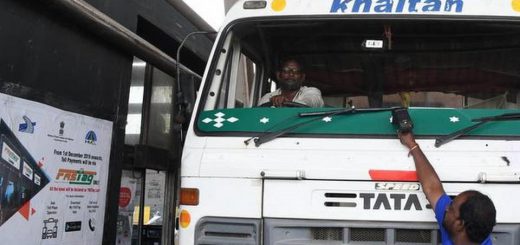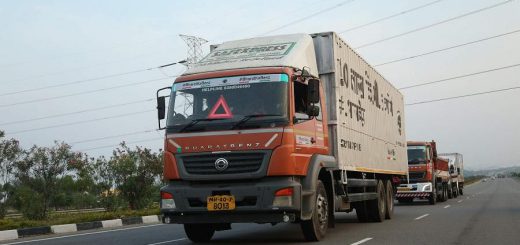India approves draft notification mandating air-conditioned trucks; OEMs applaud move
In 2021, India had the world’s highest number of road crash deaths, with over 1.53 lakh fatalities. Truck and lorry drivers contributed to more than 15,000 of these deaths, and trucks and lorries were involved in over 57,000 crashes.
The Indian government has approved a draft notification that would require all trucks belonging to categories N2 and N3 to have air conditioning systems in their cabins. The initiative, which Road Transport and Highways Minister Nitin Gadkari announced on Twitter yesterday, aims to increase truck drivers’ safety and comfort.
Trucks are classified into three categories based on their Gross Vehicle Weight (GVW). N1 trucks have a GVW of 3.5 tonnes or less, N2 trucks have a GVW of 3.5 to 12 tonnes, and N3 trucks have a GVW of 12 tonnes or more.
Gadkari said that the decision marks a “significant milestone” in providing comfortable working conditions for truck drivers, which will help to improve their efficiency and address the problem of driver fatigue. He also said that he wants the working hours for drivers to be fixed soon like they are in other countries. The government has not yet announced a timeline for the implementation of the new rule, but it is expected to come into effect in the coming months.
India’s decision to mandate air conditioning in truck cabins is a welcome step, given the country’s high rate of road accidents. In 2021, India recorded over 1.53 lakh road crash deaths, the highest in the world. Truck and lorry drivers accounted for over 15,000 of these deaths, and trucks and lorries were involved in over 57,000 crashes.
A study by the Save LIFE Foundation provides this perspective, suggesting driver fatigue is a major risk factor for road accidents in India. The study found that truck drivers often work long hours, an average of 11.9 hours per day—a significant amount of time in sweltering heat and dust. This can lead to fatigue, which can impair judgement and reaction time. In addition, the study found that 49% of truck drivers said they drive even when they are feeling fatigued or sleepy.
The same study reveals that about 9 out of 10 truck drivers drive trucks without air conditioning. The remaining 1 out of 10 truck drivers have trucks with AC. Truck drivers say they don’t use AC because it uses more fuel. This means they have to buy more fuel, which costs them more money. So, truck drivers prefer to drive trucks without air conditioning, or if their truck has air conditioning, they avoid using it. Instead, they use small fans to stay cool. It is important to note that most of the drivers get a fixed amount for their journey, which includes the cost of fuel, tolls, food, and other expenses.

Drivers are the backbone of transport sector
The development should also be seen in the context of the transport sector, which is the backbone of the Indian economy. Road transport controls 90% of passenger traffic and 67% of freight in the country. Truck drivers play a significant role in transporting India’s freight, but the unorganised nature of trucking, prevents them from getting their due share compared to their industrial counterparts.
There is a shortage of truck drivers in India. There are currently 20 lakh truck drivers, and the driver-to-truck ratio is below 750 per 1000. This means that approximately 25% to 30% of India’s trucks lie idle at any given point in time. Those who are employed in the sector are overworked, often working long trips with irregular shifts without relief. Truck drivers often endure harsh working conditions, health issues, and unscheduled working hours, which contribute to road crashes and fatalities.
OEMs give it a thumbs-up
According to Vinod Aggarwal, MD and CEO, Volvo Eicher Commercial Vehicles, the development is reflective of a progressive approach towards enhancing driver ergonomics and comfort, thereby facilitating improved road safety and efficient logistics. He added that air-conditioned cabins provide much-needed respite to truck drivers who keep the nation’s economy ticking in tough work conditions and extreme temperatures during long hours on the road. Aggarwal further continued that implementing air-conditioned cabins may result in some additional costs, with estimates ranging from Rs 30,000 to Rs 50,000, depending on the size of the vehicle. Additionally, in some models, particularly light commercial vehicles, OEMs may need to consider drivetrain changes and increased engine power to accommodate AC cabins.
“Together with improvements in highway infrastructure and vehicle emission and safety, this mandate is another positive step towards transforming the trucking industry in India by addressing one of the most important stakeholders in the logistics system: truck drivers. This will also encourage more people to take up truck driving as a profession.” Aggarwal noted.
Satyakam Arya, Managing Director and CEO, Daimler India Commercial Vehicles (DICV), said, “I believe that with air conditioning now, the cowl trucks will be gone,” adding that the second point on which more concerted effort was needed was the safety of cabins. He added that DICV never allowed cowl trucks, offering cabins that meet even the European crash safety tests.
Commenting on the development, a Tata Motors’ spokesperson said, “India’s growing trucking industry is facing the challenge of attracting and retaining skilled truck drivers. This decision will benefit the health and safety of drivers as the long hours of truck driving will become more comfortable.”
Read more at-https://shorturl.at/msvJO




Recent Comments